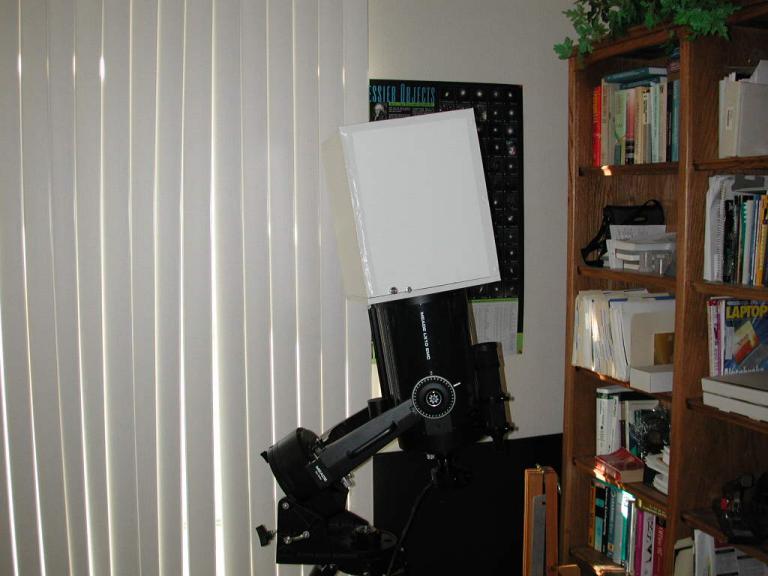This shows the lightbox sitting on top of the telescope. It isn't held on by anything, just gravity and the small lip of the aperture opening.

The view of the lightbox's "bottom", the side that sits on the LX10. The milky-white plastic diffuser plate is 1/4" plastic from a local plastics company. The two protrusions on the near side are a power input on the left and a potentiometer for adjusting brightness on the right.

Once you remove the bottom cover and flip it over, you can see how I've wired the four lightbulbs in the corner. There's a power plug (compatible with the LX10's power input so I can just move it from the LX10 to the lightbox (the LX10 doesn't need to track while taking flatfield images, of course). There's also a potentiometer that permits me to adjust the light level within the box so that the exposure for each flatfield frame is in the range 2-10 seconds (per Berry and Burnell in their excellent book Astronomical Image Processing). The lights are 6V, 25mA bulbs from Radio Shack that I end up running VERY dim in order to accomplish that 2-10 second exposure. As it turns out, the reason the CCD requires such dim light is that I was not imaging with IR blocking filters. When I changed to an IR blocking clear filter, the amount of time required increased DRAMATICALLY, about a factor of 10! The input voltage is 12V, so I have 2 sets of 2 bulbs wired in series, with the two sets wired in parallel.

Below is a flatfield image with the STV in "wide" mode and at f/3.75, Meade LX10 to create the most distinct vignetting. It was created by taking five 3.0 second flats, five 3.0 second darks, averaging the flats together, averaging the darks together, and then subtracting the averaged darks from the averaged flats.

The left image below is a raw image of M51 [STV, wide mode, f/3.75, Meade LX10, track and accumulate of 4 30 second images w/ automatic STV dark subtract] that was taken with very heavy light pollution (M51 was just above lovely stadium lighting that I have to deal with almost every night until 10 or 11pm). This setup was actually OK as the light pollution makes the vignetting in the corners much more noticable than a typical dark sky photo.
The image on the right side below is the raw image after it has
been flatfielded (i.e., the raw image is brightened where the
flatfield image shows darkening, and vice versa). The corner
vignetting has been greatly reduced, but the flat fielding doesn't
completely eliminate it. It should, so I'm working on figuring out
why it isn't.
UPDATE: The reason the single application of
flat fielding doesn't work is because each of the four images that
went into the Track&Accumulate image above each have their own
abberations and should be individually compensated before being
combined. Flatfielding a T&A image after the fact is quite a bit
more complicated that simply doing a single flatfield compensation.
 ---
---